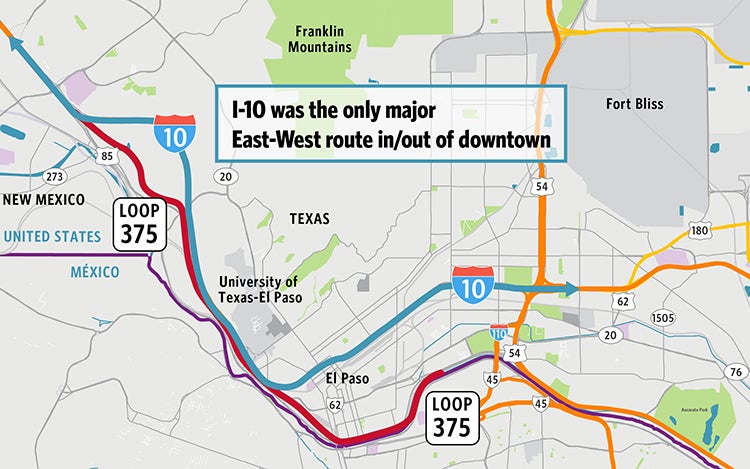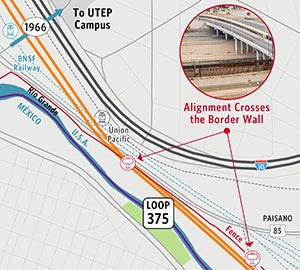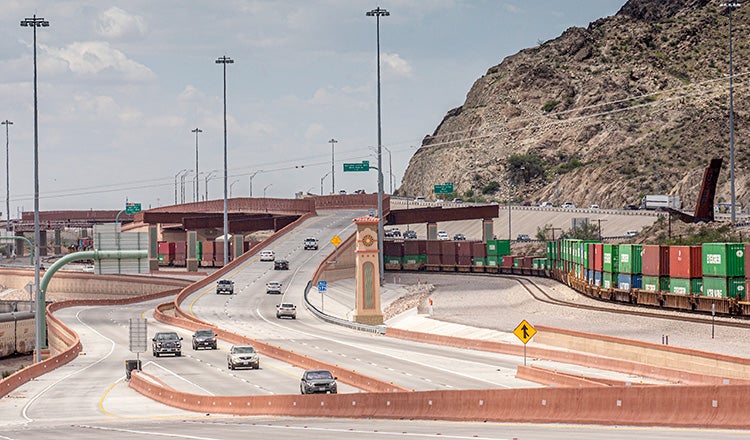Border West Expressway (Loop 375) GEC

Border West Expressway (Loop 375) GEC
Overseeing a Complex Design-Build-Maintain Expressway Along the U.S.-Mexico Border
The Border West Expressway is the newest portion, and final segment, of Loop 375 that completes the roadway encircling El Paso. In the southwest area of the city, the 7.4 mile alignment extends from Racetrack Drive near Doniphan Road and New Mexico 273 East, to connect with the Cesar Chavez Border Highway. The project corridor threads its way directly along the U.S.-Mexico border between the University of Texas El Paso campus and the border in a valley that is also home to two busy freight railroads, I-10 and US Route 85 (Paisano).
By completing the final section of roadway in Loop 375 the Border West Expressway improves mobility for the community. The El Paso metropolitan area experiences significant rush hour traffic congestion; with the Franklin Mountains to the north and the Mexican border to the south, east-west traffic movement has been constrained in the I-10 corridor.

HDR has served as an extension of Texas Department of Transportation staff under a general engineering consultant contract to oversee the design-build project delivery team. Our overall responsibility was to see that the design-builder met contract obligations, complied with regulatory requirements and delivered a maintainable roadway for the people of Texas.
Complex Stakeholder Coordination
Stakeholder coordination and teamwork were uniquely important for this project.

In a particularly constrained segment of the highway, the Border West Expressway alignment runs adjacent to the Rio Grande River and along a critical levee, crossing two railroads and crossing the international border fence twice. Overseeing construction in this segment required extensive coordination, requiring HDR to attend numerous meetings and monitor schedule and cost for TxDOT to support their approval process.
Stakeholders included:
- U.S. Customs and Border Protection Agency: The Border Patrol controlled access in and out of the construction site. All workers going outside the fence required a background check, special identification badges and special check-ins with guards. In addition, special CBP cameras, towers and lighting had to be designed and constructed to ensure proper border monitoring.
- International Boundary and Water Commission: The IBWC is responsible for handling all treaty requirements related to water, sanitation, water quality and flood control for the Rio Grande River area. Coordination was required to make sure drainage complied with treaty requirements. In addition they also required additional geotechnical analysis (such as seepage analysis) to confirm that the levees would not be compromised if a flood occurred.
- BNSF Railway and Union Pacific: These railroads parallel the roadway alignment, cross the international border, and include busy railyards in the project area. Two miles of track had to be relocated and roadway and embankment design had to accommodate railroad requirements. Work over and around the rail right-of-way and yards had special safety requirements such as flagging and constraints on work windows that impacted project execution.
- University of Texas at El Paso: The Spur 1966 segment required rebuilding complex connector ramps to tie the Border West Expressway to existing bridge and roadway to provide better access from the south to the UTEP campus.
Another section of the alignment runs through a large hazardous material site that was under remediation. Stakeholders included the State of Texas Environmental Protection Agency, the U.S. General Services Administration and the ASARCO Super Fund Trust.
Flexible Design Review
HDR’s design oversight responsibilities included monitoring design progress, reviewing design-builder design submittals for compliance with the contract, coordinating with the design-builder in issue resolution and providing recommendations to TxDOT on design changes or deviations, while assessing constructability risk that could impact schedules and the final constructed expressway .

The project’s original design included 36 bridges and over 100 retaining walls. Early in project execution the design-builder sought to alter TxDOT’s baseline design by proposing to substitute embankments for bridge structures in several segments, reducing the number of bridge structures to 27. This proposed change triggered HDR’s design oversight team to work closely with the design-builder and TxDOT performing design reviews that required:
- Complete revision of the original drainage plan by the design-builder, including extensive, careful coordination with the IBWC.
- Coordination with the cleanup contractor at the hazmat site in the alignment since the new configuration required more remediation.
- Thorough review of retaining wall configurations which included tall, complex mechanically-stabilized earth retaining walls. In one case the contractor proposed a tiered wall configuration which presented special considerations for wall geometry and integrity during construction.
Experienced Construction Oversight
HDR’s field services work included construction oversight, owner verification testing and inspection and 10% validation of material testing, and project controls that included document control, schedule review and analysis, contract compliance, change order and design-builder invoice processing.
With some $400,000 of construction going on each day, the right experience was critical in construction oversight and inspection. HDR’s staff were seasoned professionals, many formerly from TxDOT, who each brought 20 or more years of experience building infrastructure in Texas. These experienced construction professionals, many of whom worked the project from beginning to end over seven years, worked efficiently because they knew the materials and methods available locally and understood TxDOT procedures thoroughly. This experience helped them collaborate effectively with the design-builder, stakeholders and owner to generate solutions as designs were built in the field.
From the start, the project office co-located HDR’s oversight staff, the design-builder and their designer, and TxDOT. Once construction began, daily activity meetings in the field were a key tool for managing contractor activities, including any night work, so inspectors knew where to focus. Weekly meetings reviewed a three-week look-ahead schedule. The TxDOT/HDR field trailers sat right next to the design-builders’ construction trailers so staff walked back and forth regularly for discussions. Meetings in the field included whatever staff were needed to assess and resolve the question at hand — one even including 20 people to address a particularly complicated select backfill issue at a retaining wall. Throughout, the aim was to foster regular communication to resolve as many issues as possible at the lowest level possible.
Finished Roadway Popular in El Paso
The new expressway opened to traffic in October 2019. Serving as a bypass for busy I-10, the expressway handles traffic volume and serves as an alternative to I-10 when traffic conditions or construction impede traffic flow. Its completion allows TxDOT to move forward with programmed rehabilitation of I-10 and gives the people of El Paso more mobility options.








